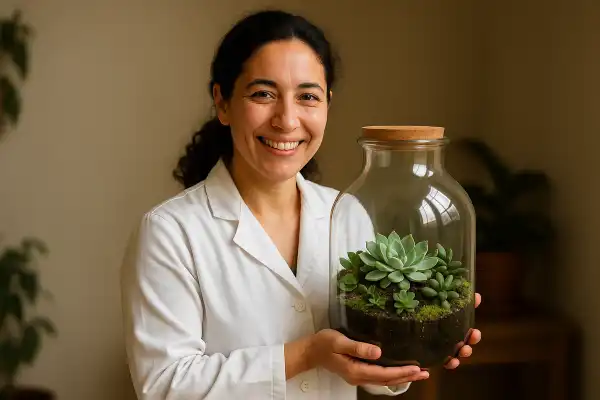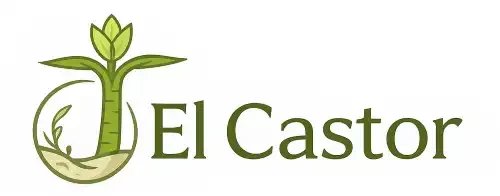What is a terrarium? This question surfaces regularly among plant enthusiasts, interior design lovers, and anyone drawn to bringing nature indoors. The curiosity stems from our innate connection to green spaces—that biophilic pull toward miniature worlds we can observe, nurture, and marvel at daily.
Recently, I helped a friend rescue a neglected glass bowl from her grandmother’s attic, transforming it into a thriving moss garden that now sits proudly on her kitchen windowsill. Watching her face light up as tiny water droplets formed their first complete cycle reminded me why terrariums capture hearts so effortlessly.
Our question of June is: Is labradorite safe to use in damp terrariums?
What is a terrarium?
A terrarium is a sealed or unsealed container that contains elements of a terrestrial ecosystem, functioning as a miniature world where plants, microorganisms, and carefully balanced environmental conditions create a self-sustaining habitat. These miniature ecosystems are not only beautiful but also intriguing in their ability to self-sustain with minimal intervention from their human caretakers.

The concept traces back to 1829, when Dr. Nathaniel Ward accidentally discovered a fern sprouting inside a glass bottle containing a moth specimen. His experiment indicated plants can be sealed, without ventilation, and continue thriving. This serendipitous discovery launched the Victorian era’s obsession with “Wardian cases,” which enabled botanical exploration across continents.
Types of Terrarium Systems
Terrariums fall into two primary categories, each supporting different plant communities and maintenance requirements.
Closed Terrariums
A closed terrarium is a sealed glass container that houses a miniature ecosystem, creating a controlled environment that creates a miniature water cycle, where the water evaporates from the soil, condenses on the glass, and falls back down into the soil, thus sustaining the plants inside. These systems excel at maintaining high humidity levels essential for tropical species.
Tropical plant varieties, such as moss, orchids, ferns, and air plants are generally kept within closed terraria to replicate their native humid, sheltered environment in the tropics. The sealed environment prevents moisture loss while allowing light penetration, creating greenhouse-like conditions that many houseplants struggle to achieve in typical indoor air.
Open Terrariums
Open-system terrariums use a container with a wide opening, such as a large glass bowl and typically accommodate plants preferring lower humidity and better air circulation. Open terraria have access to fresh air, most commonly by leaving the container open or through a hole drilled into the container.
Succulents, cacti, and Mediterranean herbs thrive in open systems where excess moisture can evaporate freely. They typically need to be watered more often than closed systems and have lower humidity levels, making them excellent choices for beginners learning plant care fundamentals.
The Science Behind Self-Sustaining Ecosystems
Understanding terrarium mechanics helps ensure long-term success and explains their fascinating autonomous behavior.
Water Cycle Mechanics
The sealed environment creates a miniature water cycle, where the water evaporates from the soil, condenses on the glass, and falls back down into the soil, thus sustaining the plants inside. This process eliminates guesswork around watering schedules while maintaining consistent moisture levels that many tropical plants crave.
Plant transpiration contributes significantly to this cycle. Leaves release water vapor through stomata, adding humidity to the enclosed air. As temperatures fluctuate throughout the day, this vapor condenses on cooler glass surfaces, forming droplets that gravity returns to the soil below.
Photosynthesis and Gas Exchange
The plants inside the closed terrarium are able to photosynthesize, which means they can produce their own food using the light that enters the container. The plants absorb carbon dioxide and release oxygen, which creates a self-sustaining environment inside the terrarium.
Even in sealed systems, some gas exchange occurs through container materials and minor seal gaps. This prevents complete oxygen depletion while maintaining the humid atmosphere plants require. The balance between photosynthesis and respiration creates a stable internal environment.
Essential Components and Construction
Building successful terrariums requires understanding each layer’s function within the ecosystem.
Foundation Layers
The Drainage Layer – A foundational structure and reservoir for excess water to drain into. Sometimes, it includes an activated charcoal layer and mesh barrier. This prevents root rot by allowing excess moisture to settle away from plant roots while maintaining overall humidity.
The Substrate Layer – The physical and nutritional support for your plants. Closed terrarium benefit from specific soil mixes to ensure ideal growing conditions and reduce risk of microbial damage; a common medium used is peat-lite: a mixture of peat moss, vermiculite, and perlite.
Beneficial Organisms
Springtails – We recommend a culture of springtails for every closed terrarium project. These super tiny, mold-fighting bugs are the single most effective way to keep your terrarium clean and healthy. These microscopic cleanup crews consume mold, fungi, and decaying organic matter before problems develop.
Isopods serve similar functions, breaking down fallen leaves and aerating soil through their movement. Both organisms contribute to nutrient cycling while preventing common terrarium issues.
Benefits and Appeal
Low-Maintenance Beauty
Just as important as a lamp or painting in creating a focal point within a room, terrariums are living sculptures that can practically care for themselves. Once established, closed systems can thrive for months or years with minimal intervention.
Air, moisture, and sunlight aid in photosynthesis, which converts light energy into carbohydrates. This is all a terrarium needs to thrive. There is no need to add fertilizer to a closed system.
Connection to Nature
Humans possess biophilia, a natural, inborn love of nature. While today’s lifestyles may not allow us to be outdoors as much as we might like, terrariums give us a small way to experience nature’s unique flora. They provide daily opportunities to observe plant growth, water cycles, and ecological interactions in miniature.
Educational Value
Terrariums demonstrate fundamental ecological principles: nutrient cycling, water conservation, symbiotic relationships, and ecosystem balance. They’re living laboratories where environmental changes produce visible results, making them excellent tools for understanding larger natural systems.
Conclusion
Just last weekend, I found myself kneeling beside my newest creation—a massive glass cloche housing a community of native mosses and tiny ferns I’d collected during a morning walk. As I watched the first dewdrops form along the glass curve, I remembered why these miniature worlds fascinate me so deeply. Each terrarium represents our ability to partner with nature, creating sustainable beauty that thrives through careful observation and gentle intervention. Through six years of building these glass gardens, I’ve learned that the most rewarding terrariums aren’t just plant collections—they’re glimpses into the remarkable resilience and interconnection that makes our natural world so extraordinary.
El Castor is your exclusive terrarium guide.
